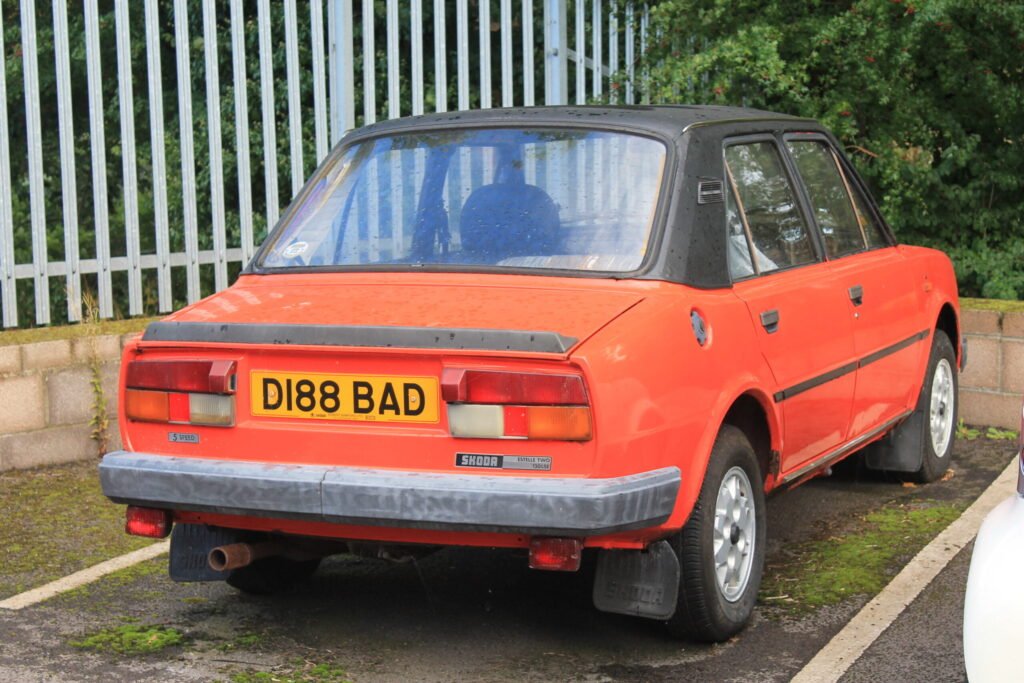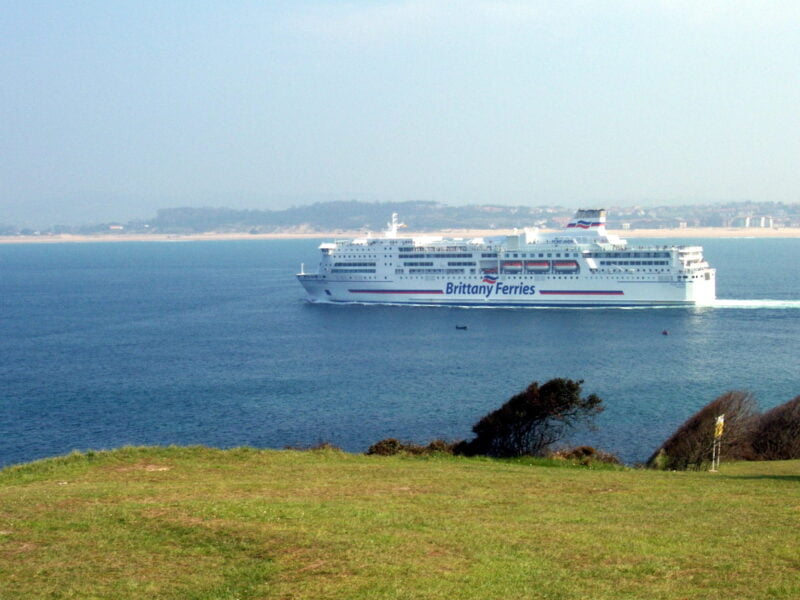Travelling by ferry and driving in Europe should be pretty simple and straight forward, right? Well, if you’re organised then yes, it is, but if you don’t make yourself aware of the many and varied ferry travel requirements, then it won’t be smooth sailing. Take my mum for example – back in the mid 80’s she rocked up to Portsmouth sans visa (as an Aussie native). We therefore fell at the very first hurdle, and only began our French odyssey a few days (and a quick trip up to London’s embassy district) later. It really is rather important therefore that you have all your documents in order before arriving at the port! So, in this post, we’ll help you get to know the most common ferry travel requirements way before you leave home, so that you’re stress free and driving safely in Europe.

TRAVELLING BY FERRY: FAQ
Do you need a passport to go on a ferry?
Let’s start with the basics here. Yes, you do need a passport to go on a ferry to France, Spain or any other country! As you’ll be leaving one country and entering another you need a valid passport for international travel, this is no different from if you were flying. Equally, P&O ferries passport requirements are the same as those for Irish Ferries, DFDS, Brittany Ferries and all other companies – as these passport requirements align with rules for travelling to the EU. Check the expiration date on your passport to ensure it remains valid throughout your trip – it’s a good idea to make sure it has at least 3 months validity left, as this is often required by many European nations. Depending on which passport you carry, some routes may also require a visa (as we learnt the hard way), so check the entry requirements for your specific destination.
Do I need a car sticker to drive in Europe?
When driving outside the UK, it may be necessary to affix a white oval UK sticker to the rear of your vehicle. This requirement depends on the configuration of your number plate and your intended destination. Basically, if your number plate already features the UK identifier accompanied by the Union Jack you don’t need a separate UK sticker.
However, a UK sticker is mandatory if your number plate falls into any of the following categories:
- Comprises solely numbers and letters, devoid of any flags or identifiers.
- Displays a GB identifier alongside the Union flag.
- Incorporates a European Union flag.
- Features a national flag of England, Scotland, or Wales.
Note that UK stickers have superseded the previous white oval GB stickers, so if you currently have a GB sticker, it must either be covered or removed before driving outside of the UK. Don’t attach the sticker directly onto your number plate.
Driving in Spain, Cyprus, and Malta: To drive in Spain, Cyprus, or Malta, you must ALWAYS display a UK sticker, regardless of the content of your number plate.
Driving in the Republic of Ireland: When driving in the Republic of Ireland, there is no need for a UK sticker, regardless of the content of your number plate.

How much alcohol can you bring back from Europe to the UK?
Now we’re talking! Be aware of the limits for bringing booze and other goodies back to the UK, as if you’re way over the limits you may get fined and have them confiscated. Full details for bringing alcohol into the UK can be found here on the official UK govt website, but in summary, alcohol allowance depends on the type of booze you’re bringing back:
beer = 42 litres AND/OR wine (still) = 18 litres
It gets a bit more complicated when you move away from beer and wine, in that you can ALSO bring in either:
spirits over 22% = 4 litres OR ‘other alcoholic drinks up to 22%‘ = 9 litres
Other alcoholic drinks’ in this case usually refers to cider, port, sherry and sparkling wines. According to the gov.uk website, “You can split this last allowance. For example, you could bring 2 litres of spirits and 4.5 litres of fortified wine.”
What vehicles types are usually allowed on ferries?
The types of vehicles allowed on Brittany Ferries, P&O and the rest typically include:
- Passenger cars: Most ferry routes are open to standard passenger cars, including hatchbacks, saloons and small SUVs.
- Motorcycles: Motorcycles are generally allowed on board ferries, although you will of course need to secure your motorcycle properly during the crossing.
- Campervans and motorhomes: Brittany Ferries and P&O Ferries usually welcomes campervans and motorhomes of various sizes, provided they meet the length and height restrictions for the specific ferry route.
- Bicycles: Most Brittany Ferries and P&O vessels allow bicycles, and they are often carried free of charge. You’ll be directed to a designated areas for securing your bike during the journey.
- Pedestrians: Of course, if you’re traveling without a vehicle, you can just book a ticket as a foot passenger!
- Caravans and trailers: Caravans and trailers are generally allowed on Brittany Ferries and P&O, but there may be restrictions based on size and weight. It’s advisable to check the specific requirements for the route you plan to take.
- Vans, coaches and commercial vehicles: Some routes may allow vans and commercial vehicles, but this can vary depending on the ferry and destination. There might be specific requirements or limitations on the size and weight of these vehicles so check first before booking.
Remember that the specific rules, regulations, and restrictions for vehicle types vary depending on the ferry route, vessel, and destination so check the website of your ferry company for the most up-to-date info.
Can I travel as a foot passenger and then rent a car in Europe?
Absolutely, you can! But be careful here. For many reasons, it might be worth considering buying your ferry tickets as foot passengers, and then renting a car in France or Spain upon arrival…
- If you’re price sensitive then this could save you money, although obviously you need to make sure that the cost of the car rental itself doesn’t outweigh the savings made on your ferry ticket!
- Renting a car in-situ may also make more sense for you if your existing UK car insurance or breakdown cover doesn’t cover international trips.
- Renting a car in France, Holland or Spain would also make sense if you’re worried about driving on the right in a vehicle with its steering wheel also on the right. This makes overtaking pretty dangerous guesswork, unless of course you’ve always got a willing passenger to help you check for oncoming vehicles!
If you are a little freaked out about driving on the right in a right hand drive car, then check out Discovercars.com, as they aggregate the best prices of local vehicles from French, Dutch and Spanish car hire companies which avoids this issue. Here’s a link to P&O’s info all about travelling as a foot passenger. Here’s all the info about travelling as a foot passenger with Brittany Ferries too.

Travelling by ferry: Document Requirements For Individuals
What ID requirements are there for individuals travelling by ferry?
- Passport and ID requirements: As already stated above, ensure you have a valid passport for international travel for all passengers, regardless of whether you are traveling a foot passenger or with a vehicle.
- Driving license: most people who board ferries are doing so in their vehicles, so don’t forget to bring your driving license!
- Ticket or booking confirmation: You will need your ferry ticket or booking confirmation to board the ferry. Make sure you have both a printed copy and an electronic version for reference.
- Travel insurance: an electronic or paper copy of your travel insurance makes sense.
- Pets and pet travel: If you are traveling with pets, review the pet travel requirements for Brittany Ferries, P&O, or whichever other ferry company you are traveling with. This may include documentation of vaccinations, micro-chipping, and health certificates.
As always, the rules for travelling by ferry may change over time, so it’s probably worth checking again just before your departure, especially if you booked your ferry tickets a while back.
Travelling by ferry & Driving in Europe
What documents and permits do I need for my vehicle when driving in Europe?
- Driver’s license: You should have a valid driver’s license from your home country. Some countries may require an International Driving Permit (IDP) in addition to your regular driver’s license. Check the specific requirements for the country you plan to visit.
- Vehicle registration: Carry your vehicle’s registration documents, which prove ownership and registration in your home country.
- Insurance and breakdown cover: Ensure you have valid vehicle insurance coverage for the countries you intend to visit. Contact your insurance provider to confirm that your policy covers driving in Europe and meets the minimum requirements of the countries you plan to visit. Ensure that your policy includes international breakdown/accident cover and have this with you at all times in case anything does happen.
- Passport and ID: Always carry your passport or identity card, as you may be required to show it if stopped by authorities.
- Environmental stickers: In some European cities, particularly in the increasing number of low emission/environmental zones, you may need an environmental sticker (e.g., Crit’Air in France) to enter certain areas. These stickers are usually only required for older, more polluting vehicles though.
- Toll tags and vignettes: Some European countries require payment of tolls or the purchase of vignettes (road tax stickers) for certain highways or roads. Check the specific requirements for the countries and cities you plan to visit.
What safety equipment do I need when driving in Europe?
- Reflective vests: In many European countries, it is a legal requirement to carry high-visibility reflective vests or jackets in the car. These should be easily accessible and used when you exit the vehicle in case of an emergency or breakdown.
- Warning triangle: A warning triangle is required in many European countries. It should be placed behind your vehicle to warn other drivers in case of a breakdown or accident.
- First aid kit: While not mandatory everywhere, it is advisable to carry a first aid kit in your vehicle.
- Headlamp beam deflectors: If your car has right-hand drive and you’re driving in a country that drives on the right side of the road, you may need headlamp beam deflectors to avoid blinding oncoming drivers.
Ferry Travel Requirements - other things to consider
- Arrival time and boarding: When travelling by ferry always make sure to arrive at the ferry terminal well in advance of your departure time. Boarding procedures tend to vary depending on your route so do follow whatever instructions were provided by the ferry company.
- Customs and immigration procedures: Be prepared to go through customs and immigration procedures either upon arrival at your destination or prior to your departure at your home port, and familiarise yourself with the customs regulations of both.
- Luggage and baggage: Be aware of baggage allowances and restrictions. Oversized or excess luggage may incur additional fees, although one of the key advantages of ferry travel over flying is the ability to travel with way more, so this is unlikely to be much of an issue.
- Onboard facilities: Find out what onboard facilities and amenities are on offer during your journey, including restaurants, cabins, duty free shops and maybe even a swimming pool, a kids club or a cinema on one or two of the longer routes! This is what I like to do straight after boarding and it was always one of the most exciting parts of the whole ferry experience for me (as well as getting out on deck and watching as you pull away from the port).
- Accessibility requirements: If you have specific accessibility or dietary needs, check out the following links to both Brittany Ferries and P&O in advance to check whether suitable accommodation and assistance are available on your selected route.
- Prohibited and dangerous items: Ferry companies each have their own policies on exactly what isn’t allowed onto their ferry fleet so, again, check directly with them.
Things to know when travelling by ferry: Conclusion
There are always a ton of things to do before going on holiday and all of this does sound like a lot, but follow these general requirements for travelling by ferry and for driving in Europe, and you’ll be set to enjoy a wonderful holiday. If you’re looking for inspiration on which ferry route would suit you, then do check out our post on the best UK to France ferry crossings or the options you have for taking a ferry to Spain. Also, for those of you who may be traveling as foot passengers and want to arrive to your UK ferry port in the greenest possible way via train, then check out Trainpal to save an extra 5% on UK train tickets – as a new customer just use the code RC77 on their website or the app to get the discount. It’s probably also worth checking to see if you can beat the prices of the ferry companies by also checking with Direct Ferries. Here’s wishing you a stress free holiday and many happy hours on your hols!






Travelling afternoon from Portsmouth, arriving Caen late evening. My husband has food allergies and we will be packing a picnic supper. Do we clear customs before boarding the ferry, or on arrival in France?
Similar question for the return trip a week later (July) when we leave France 8.30 a.m.
Hi Jacky,
Thanks for your question! You’ll be going through customs on arrival in Caen, and it’s the other way around on your return to trip to Portsmouth, but be sure to have all your documents (including for passport control) within easy reach at both ports in each direction.
Not sure if baguettes, brie and wine are on your husbands banned list of foods, I certainly hope not for his sake!
Have a great trip – James